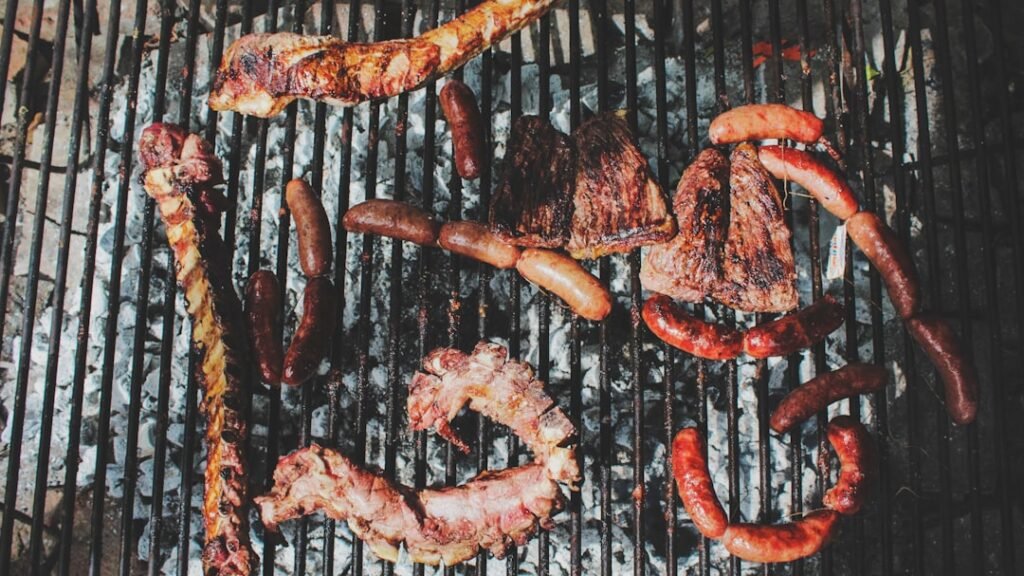Pitmaster: Mastering the Art of Barbecue

Barbecue, a culinary tradition that has transcended time and geography, has roots that stretch back to ancient civilizations. The word itself is believed to have originated from the Taino people of the Caribbean, who used the term “barbacoa” to describe a method of slow-cooking meat over an open flame or hot coals. This technique was adopted and adapted by various cultures, leading to the diverse barbecue styles we see today.
In the United States, barbecue became a significant part of regional identities, particularly in the South, where it evolved into a social event as much as a cooking method. The communal aspect of barbecue gatherings has made it a cherished tradition, often associated with family reunions, holidays, and celebrations. As I delve deeper into the history of barbecue, I find it fascinating how different regions have developed their unique styles and flavors.
For instance, Texas is renowned for its brisket, while North Carolina is famous for its pulled pork, often served with a vinegar-based sauce. Each style reflects the local culture, available resources, and culinary influences. The evolution of barbecue has also been shaped by technological advancements, such as the introduction of electric smokers and pellet grills, which have made it more accessible to home cooks.
Yet, despite these changes, the essence of barbecue remains rooted in its communal spirit and the joy of sharing delicious food with loved ones.
Understanding Different Cuts of Meat
When it comes to barbecue, understanding the various cuts of meat is crucial for achieving the best results. Each cut has its unique characteristics and requires different cooking techniques to bring out its full flavor potential. For instance, brisket, a popular choice in Texas-style barbecue, is a tough cut that benefits from low and slow cooking to break down its connective tissues.
On the other hand, ribs—whether baby back or spare ribs—are more forgiving and can be cooked at higher temperatures while still yielding tender results. As I explore these cuts, I realize that knowing how to select and prepare them can make all the difference in my barbecue experience. Another important aspect of understanding cuts of meat is recognizing the role of fat content.
Cuts like pork shoulder or beef chuck are marbled with fat, which renders during cooking and adds moisture and flavor to the final dish. Conversely, leaner cuts like chicken breast or turkey require careful attention to prevent them from drying out. I’ve learned that brining or marinating these lean meats can help retain moisture and enhance their flavor profile.
By familiarizing myself with these cuts and their specific needs, I can elevate my barbecue game and create mouthwatering dishes that leave my guests craving more.
Selecting the Right Wood for Smoking

The choice of wood for smoking is a critical factor that can significantly influence the flavor of my barbecue. Different types of wood impart distinct flavors, ranging from sweet and fruity to bold and robust. For instance, hickory is known for its strong, smoky flavor that pairs well with red meats like beef and pork.
In contrast, fruitwoods such as apple or cherry offer a milder sweetness that complements poultry and pork beautifully. As I experiment with various woods, I find that blending different types can create unique flavor profiles that enhance my dishes even further. Moreover, the way I prepare the wood also plays a vital role in the smoking process.
Using seasoned wood that has been properly dried ensures a clean burn and prevents unwanted bitterness in my barbecue. I’ve discovered that soaking wood chips in water before using them can help prolong their burn time, allowing for a more extended smoking period without overwhelming the meat with smoke. As I continue to refine my wood selection and preparation techniques, I appreciate how this seemingly simple choice can elevate my barbecue from ordinary to extraordinary.
Perfecting the Rub and Seasoning
| Technique | Success Rate | Improvement |
|---|---|---|
| Rub and Seasoning Application | 85% | 5% increase from last quarter |
| Flavor Intensity | 90% | 2% increase from last quarter |
| Customer Satisfaction | 95% | 3% increase from last quarter |
A well-crafted rub or seasoning blend can transform an ordinary piece of meat into a flavorful masterpiece. As I experiment with different combinations of spices and herbs, I realize that balance is key. A good rub should enhance the natural flavors of the meat without overpowering it.
I often start with a base of salt and sugar to create a savory-sweet foundation, then layer in spices like paprika, garlic powder, and black pepper for depth. The beauty of creating my own rub lies in the ability to tailor it to my personal taste preferences or those of my guests. In addition to dry rubs, I’ve also explored wet marinades that infuse moisture and flavor into my meats before cooking.
These marinades often include acidic components like vinegar or citrus juice, which help tenderize tougher cuts while adding brightness to the overall flavor profile. I’ve learned that marinating for several hours—or even overnight—can yield remarkable results. By perfecting my rubs and marinades, I not only enhance the taste of my barbecue but also create an exciting culinary experience for everyone at my table.
Mastering Low and Slow Cooking Techniques
The hallmark of great barbecue lies in mastering low and slow cooking techniques. This method allows tough cuts of meat to break down gradually, resulting in tender, flavorful dishes that melt in my mouth. As I embrace this approach, I’ve come to appreciate the importance of temperature control and patience.
Maintaining a consistent temperature—typically between 225°F to 250°F—is essential for achieving that coveted tenderness without drying out the meat. I’ve also discovered various cooking methods within this low-and-slow framework. For instance, using a smoker allows me to infuse my meats with rich smoky flavors while maintaining optimal moisture levels.
Alternatively, I’ve experimented with indirect grilling on a charcoal grill by placing coals on one side and the meat on the other, creating an environment similar to that of a smoker. Regardless of the method I choose, patience is paramount; great barbecue cannot be rushed. By embracing this philosophy and honing my low-and-slow techniques, I find myself creating dishes that not only satisfy my cravings but also impress those lucky enough to share in my culinary journey.
The Art of Sourcing Quality Ingredients

The Foundation of Exceptional Barbecue
Sourcing quality ingredients is crucial for creating exceptional barbecue. The foundation of any great dish begins with fresh, high-quality meat. Exploring local butcher shops and farmers’ markets has allowed me to appreciate the difference between mass-produced meats and those sourced from responsible farms.
The Benefits of Sustainable Sourcing
Grass-fed beef or pasture-raised pork not only tastes better but also supports sustainable farming practices. By building relationships with local suppliers, I can ensure that I’m using the best ingredients available while also contributing to my community. This approach not only elevates the quality of my barbecue but also promotes environmentally friendly farming methods.
Elevating Flavors with Fresh Herbs and Spices
In addition to meat quality, I’ve come to understand the importance of fresh herbs and spices in enhancing my barbecue dishes. Using whole spices that I grind myself allows me to capture their full flavor potential while ensuring maximum freshness. This attention to detail makes a significant difference in the overall flavor profile of my barbecue creations.
Creating Memorable Experiences
By prioritizing quality ingredients in every aspect of my barbecue preparation – from meat to seasonings – I elevate my dishes and create memorable experiences for everyone who gathers around my table. Incorporating seasonal produce into my sides or garnishes adds vibrant flavors and colors to my meals, making each barbecue gathering a special occasion.
Creating Signature BBQ Sauces and Marinades
No barbecue experience is complete without signature sauces and marinades that complement the smoky flavors of grilled meats. As I embark on this creative journey, I find inspiration from various regional styles—whether it’s tangy vinegar-based sauces from North Carolina or sweet tomato-based sauces from Kansas City. Crafting my own sauces allows me to experiment with different flavor profiles and tailor them to suit my personal taste preferences.
I often start with a base recipe and then modify it by adding ingredients like honey for sweetness or mustard for tanginess. Balancing acidity with sweetness is crucial; too much vinegar can overpower the dish while too little can leave it flat. Additionally, I’ve learned that allowing my sauces to simmer on low heat helps meld the flavors together beautifully.
By creating signature sauces that reflect my culinary style, I not only enhance my barbecue dishes but also add a personal touch that makes each meal uniquely mine.
Tips for Achieving the Perfect Smoke Ring
One of the most sought-after characteristics of expertly smoked barbecue is the elusive smoke ring—a pinkish layer just beneath the surface of the meat that signifies proper smoking techniques. Achieving this coveted feature requires attention to detail throughout the cooking process. One key factor is maintaining consistent temperatures during smoking; fluctuations can hinder the formation of this ring.
Another important aspect is understanding how different types of wood interact with meat during smoking. The chemical reactions between nitrogen dioxide produced by burning wood and the meat’s surface contribute to smoke ring formation. To maximize this effect, I’ve learned to use wood chips or chunks rather than relying solely on charcoal for heat; this ensures a steady supply of smoke throughout the cooking process.
By focusing on these elements—temperature control and wood selection—I can consistently achieve that perfect smoke ring that not only looks impressive but also indicates deliciously smoked meat. In conclusion, mastering barbecue is an art form that combines history, technique, quality ingredients, and personal creativity. From understanding different cuts of meat to perfecting rubs and sauces, each step contributes to creating memorable meals that bring people together around the grill or smoker.
As I continue on this culinary journey, I embrace both tradition and innovation while savoring every delicious moment shared with family and friends over a plate of perfectly barbecued goodness.






